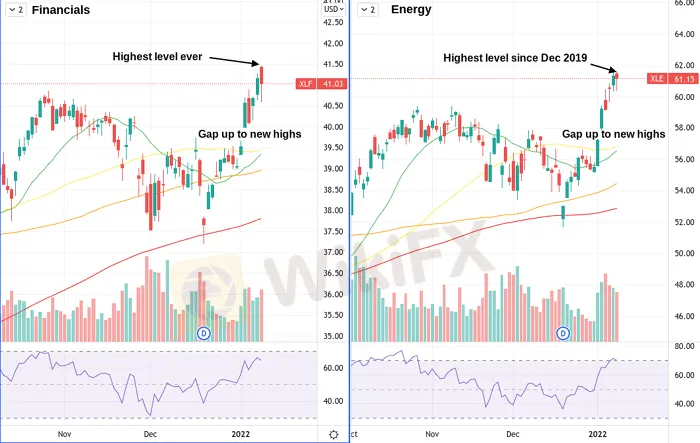简体中文
繁體中文
English
Pусский
日本語
ภาษาไทย
Tiếng Việt
Bahasa Indonesia
Español
हिन्दी
Filippiiniläinen
Français
Deutsch
Português
Türkçe
한국어
العربية
Fed Ramps Up Hawkish Talk; Tech Sells Off, Dip-buyers Return
Abstract:In what seemed like a dress rehearsal for a more sustained taper tantrum, US markets sold off last week when Fed minutes released from Decembers FOMC

In what seemed like a dress rehearsal for a more sustained taper tantrum, US markets sold off last week when Fed minutes released from Decembers FOMC meeting suggested that the central bank was considering hiking interest rates sooner, and more aggressively, than expected.
Normally FOMC meeting minutes are somewhat of a non-event as the major insights tend to be communicated during the post-meeting press conference. However, this year weve had at least two occasions when the release of the minutes has spooked markets into a risk-off mood.
Yields up, stocks down
A combination of soft PMI data, down to 58.7 in December from 61.1 in November, along with a contraction in JOLTS job openings, caused US markets to sell off on Tuesday, January 4. This set the stage for a more pronounced rout on Wednesday when the minutes were released.

The bond market sold off, which had the effect of spooking tech stocks, particularly as 10-year yields rose to 1.764% for the first time since March of last year. Crypto also took a significant hit; the broad market was down by around 6% on the day as investors with paper profits from 2021 begin to weigh how slowing growth and a more hawkish Fed are likely to dampen the enthusiasm for risk assets.
The S&P 500 was down over 1.8% on the day. The Nasdaq 100 fell by around 2.7%, and the Russell 2000 dropped by more than 3.3%.
Sector rotation?
A great deal has been made recently about the fact that the percentage of Nasdaq 100 stocks that are down by 50% or more from their 52-week highs is almost at record highs. We haven‘t seen a situation when so many of the index’s stocks are down despite it trading close to highs since the dot-com bubble of 2000.
The best performing sectors in the first week of January, following the selloff, were Financials and Energy, up 7% and 4% on the week, respectively. This has caused many to speculate about a broader sector rotation. Whether this proves to be the case or not, you can see the markets concerns present in this mini rotation. Financials are set to perform well in an environment of rising rates. Also, with inflation concerns still front and centre, and the worst of the winter still not over with, energy seems like a smart bet for many investors.



Disclaimer:
The views in this article only represent the author's personal views, and do not constitute investment advice on this platform. This platform does not guarantee the accuracy, completeness and timeliness of the information in the article, and will not be liable for any loss caused by the use of or reliance on the information in the article.
Read more

Will the Euro and US Dollar Reach Parity in 2025?
Euro-dollar parity sparks debate again as 2025 approaches, with multiple factors shaping the exchange rate outlook.

US Dollar Surge Dominates Forex Market
The global forex market continues to show volatility, with the U.S. dollar fluctuating last week but overall maintaining a strong upward trend. How long can this momentum last?

Oil Prices Soar for 5 Days: How Long Will It Last?
Last week, the global oil market saw a strong performance, with Brent crude and WTI crude prices rising by 2.4% and around 5% respectively. Oil prices have now posted five consecutive days of gains. But how long can this rally last?

How Big is the Impact of the USD-JPY Rate Gap on the Yen?
The U.S. Federal Reserve's repeated rate cuts and the narrowing of the U.S.-Japan interest rate differential are now in sight. So, why is the U.S.-Japan interest rate differential so important for the yen’s safe-haven appeal, especially when global economic uncertainty rises?
WikiFX Broker
Latest News
BI Apprehends Japanese Scam Leader in Manila
Bitcoin in 2025: The Opportunities and Challenges Ahead
Join the Event & Level Up Your Forex Journey
Is There Still Opportunity as Gold Reaches 4-Week High?
Bitcoin miner\s claim to recover £600m in Newport tip thrown out
Good News Malaysia: Ready for 5% GDP Growth in 2025!
How to Automate Forex and Crypto Trading for Better Profits
FXCL Lucky Winter Festival Begins
Warning Against MarketsVox
Is the stronger dollar a threat to oil prices?
Currency Calculator






